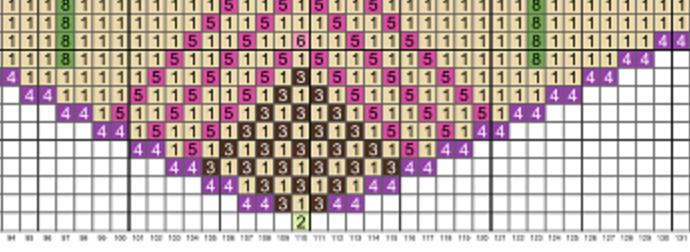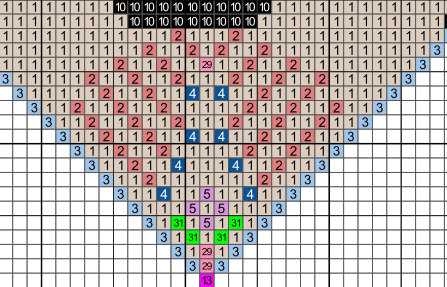While all my patterns come in written format with Uk and US terminology, I also utiliise a colour block graph to help clarify stitches. You will see that I mention this with many of my patterns in that they come with an added colour block graph. Here I will explain just a bit about this.
This is my own form of graphing and works a lot like a filet crochet graph. I started using this method a few years back and found it works great. Trying to draw up whole patterns for things like blankets, with a symbol graph can be difficult, messy and take a massive amount of time. Many of the programs you can use for this do offer basic symbols but more advanced symbols, or anything out of the ordinary becomes a problem. These block graphs can be worked in the round and the examples shown are blanket that do not turn. I have done a number of patterns using colour blocks that are worked in rows and turn, but the examples here do not. These are worked from left to right.
I use 2 forms of colour block graphs:
Colour Block Graph 1:
With blankets I graph one side. With the blanket graph shown below this blanket was square. Once the corner No4- Purple is worked you repeat the graph again, across the next side. You continue in this manner until you get back to your starting point.
In this block graph, each colour denotes just one stitch. Earlier block graphs I just used a colour to distinguish the stitches but I have no advanced to colour and no on each block.
Each graph comes with a key stating what colour and number denotes each stitch. Below is an example of one of my latest graphs.
Explanation of a few of these colours and their meaning:
No4- Purple- Each block denotes 1 double crochet (US) in the corner.
No3- Black- Each blok denotes 1 chain.
No1- Beige- Each block denotes 1 double crochet (US) in the main body of the work.
Colour Block Graph 2:
Each block in this style of colour block graph denotes 3 stitches. The last stitch in the first block, is the first stitch in the next block. These are a little bit trickier to use but sometimes to gain a beautiful picture blanket, this style of colour block graph works best. My Batten Down The Hatches Blanket uses this style of block graph.
This is much like a filet crochet graph but with basic filet crochet, the stitches don’t vary greatly. I use anything and everything in my blankets and often stitches I have made up myself.
Again the earlier of my colour block graphs of this style only came with colours. The last pattern that I put out to test had so many stitch variations that I was running out of colours and so decided to start using numbers as well, in an effort to make the colours easier to distinquish.
You will note by the example graph below. Describing the 3rd round of the graph below: From left to right. No3- Blue- this block begins in the second half of the square blanket corner. and is made up of 2 double crochet (US) in the corner and 1 double crochet (US) after the corner. The next block is No1- beige- This is comprised of 3 double crochet (US). After this is N029-Salmon- This is made of of 1 double crochet (US), 1 Front post treble (US), and 1 double crochet (US). then we have No1- Beige- 3 double crochet (US). The last block in this side of the blanket is No3- Blue- 1 double crochet, 2 double crochet into the corner.
Again this of course has a graph key to state what blocks denote what stitches (remember this style of colour block graph denotes 3 stitches per colour. . Below shows the cropped picture of the graph key shows just a couple of the stitches and the meaning. Of course there are many more stitches involved in this project but this is just an example.
Hopefully you will find my explanation of my colour block graphs helpful.



